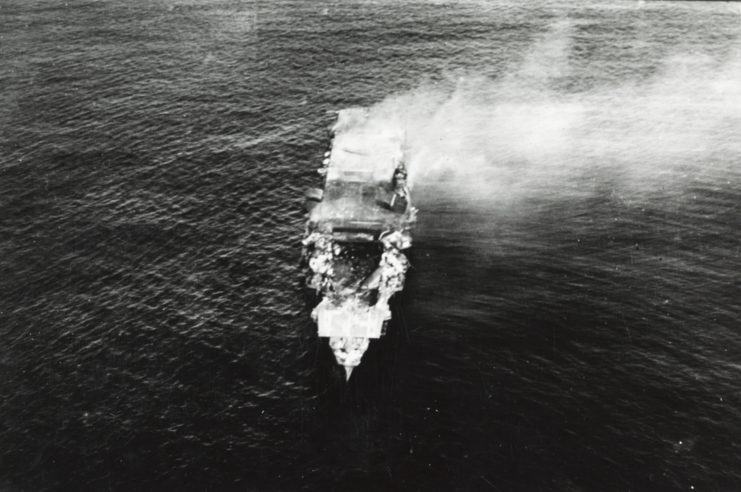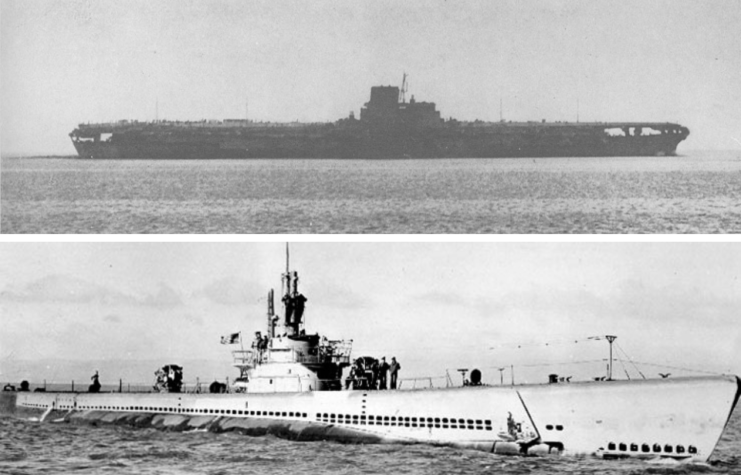During the Second World War, the Imperial Japanese Navy (IJN) constructed several large warships, with the IJN Shinano standing out. Originally planned as a Yamato-class vessel, a strategic decision led to her conversion into an aircraft carrier, a response to the significant losses suffered by the Japanese fleet during the Battle of Midway.
Shinano‘s service is particularly noteworthy, as she holds the distinction of being the largest warship in history to be sunk by a submarine.
Construction of the IJN Shinano
The construction of the IJN Shinano commenced on May 4, 1940, at the Yokosuka Naval Arsenal as the last vessel in her class. Initial progress was smooth, but, in 1942, orders were issued to transform the battleship into an aircraft carrier. This shift was necessitated by the losses the Japanese had incurred at the hands of the Americans.
Instead of becoming a fleet carrier, she was reconfigured as a 65,800-ton, heavily-armored support carrier primarily intended for reserve aircraft and fuel storage.


The construction of Shinano was shrouded in the utmost secrecy, shielded from prying eyes by a high fence that encircled the construction site. Those laboring on the vessel were bound by a strict oath of silence, subject to execution if they breached it.
Consequently, Shinano stands as the sole major warship of the 20th century for which no photographic records exist of her construction. Even after her completion, she was captured on film only twice: by a Boeing B-29 Superfortress that was on a reconnaissance mission and by a civilian during sea trials.
Armor and armament
The IJN Shinano underwent modifications influenced by the design of the Yamato and Musashi. Initially intended to feature armor 10-20 mm thinner and equipped with newer anti-aircraft guns, these specifications underwent alterations when she was repurposed as an aircraft carrier. As a result, Shinano deviated greatly from the appearance of a Yamato-class ship, shedding a substantial portion of her armor and large main guns.
In her transformed state, Shinano adopted the characteristic flat top of aircraft carriers and an inline flight deck.
Shinano boasted impressive dimensions, measuring a length of 872 feet, with a beam of 119 feet and a draught of nearly 34 feet. Her power source comprised 12 Kampon water boilers, fueling four geared steam turbines that, in turn, drove an equal number of shafts, generating 150,000 shaft horsepower. Under optimal conditions, this configuration allowed the aircraft carrier to achieve a surface speed of approximately 27-28 knots.
Designed to accommodate a diverse array of aircraft, Shinano was considered defensively robust among carriers. She featured eight twin five-inch dual-purpose guns, 35 triple one-inch anti-aircraft guns and twelve 28-barrel 4.7-inch anti-aircraft rocket launchers. Along the waterline, Shinano‘s armor ranged from 160-400 mm in thickness, while the flight deck boasted a 75 mm armor.
Traveling toward certain destruction
While the IJN Shinano was initially scheduled for commissioning at the start of 1945, her construction timeline was accelerated following the Battle of the Philippine Sea, during which the Japanese suffered the loss of two fleet carriers, one light carrier and two oilers, with several smaller ships sustaining damage.
The push to hasten the vessel’s completion resulted in subpar workmanship on later components. Nevertheless, Shinano was launched on October 8, 1944, and commissioned on November 19 of the same year.
At this point, Shinano was slated to journey from her shipyard to Kure Naval Base, where she would be equipped with armaments and receive aircraft under the command of Capt. Toshio Abe. Despite pressure from superiors to depart promptly, Abe requested a delay due to incomplete bailing pumps and fire mains. Unfortunately, his appeal was rejected, and he was compelled to embark on his voyage at night, contrary to his preference for daytime departure.
Setting sail for Kure at 6:00 PM on November 28, 1944, Shinano was accompanied by Isokaze, Yukikaze and Hamakaze. While en route, the ships detected the radar signals of an American submarine in the vicinity, prompting them to maneuver in zig-zag patterns in an attempt to evade detection. Unbeknownst to the crew, this maneuver inadvertently placed Shinano directly in the path of the USS Archerfish (SS-311).
Sinking of the IJN Shinano
The USS Archerfish, under the command of Cmdr. Joseph Enright, had clocked the IJN Shinano two hours before the submarine was noticed by the Japanese aircraft carrier. Abe, believing they’d encountered an American wolfpack, ordered his ships to turn away from Archerfish, in an attempt to outrun the submersible. This would have worked, as Shinano was the faster out of the two, but she was forced to reduce her speed to prevent damage to the ship.
By 2:56 AM on November 29, Abe had changed direction to move toward the submarine, only to turn southwest, exposing the entire side of the ship to Archerfish. At 3:15 AM, Enright made the call to fire six torpedoes at their target, ensuring the first two hit before diving to a depth of 400 feet to wait it out.
Four of the torpedoes hit Shinano, which was enough to sink her. Enright and his crew didn’t know what ship they’d sunk until the Second World War was over, nor that it took over seven hours for the aircraft carrier to go down.
Hindsight is 20/20
Initially, those aboard the IJN Shinano underestimated the severity of the damage caused by the torpedo strikes, meaning minimal effort was made to salvage the ship. Abe, in particular, directed her to maintain maximum speed, inadvertently accelerating the flooding of the aircraft carrier.
Unfortunately, by the time they grasped the gravity of the situation, it was too late. The ship had become too heavy to be towed by escort vessels, too inundated to be pumped out and too irreparably damaged for the majority of her crew to evacuate. Out of her 2,400-man crew, 1,435 perished with the ship, including Abe and both navigators.
The survivors were sent to Mitsukejima until January of the subsequent year, preventing the widespread dissemination of news about Shinano‘s sinking. Following the conclusion of the war, the US Navy analyzed the aircraft carrier, along with other Yamato-class ships, and identified significant design flaws that rendered specific joints susceptible to leakage. It was concluded that the torpedoes from the USS Archerfish happened to strike these vulnerable joints, contributing to Shinano‘s demise.
More from us: Was Henry Breault Late to His Own Medal of Honor Ceremony?
Want War History Online‘s content sent directly to your inbox? Sign up for our newsletter here!
Regarding Enright, US Naval Intelligence initially doubted his claim of sinking a Japanese carrier, believing all had been identified. However, this was rectified after the war, and Enright was duly honored with the Navy Cross for his victorious achievement.


Leave a Comment